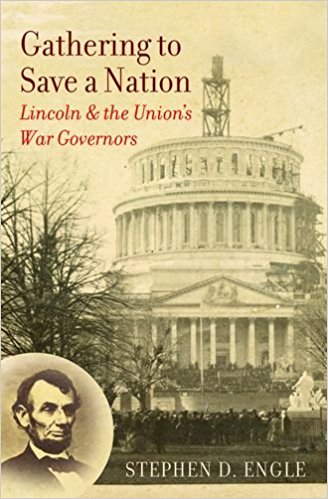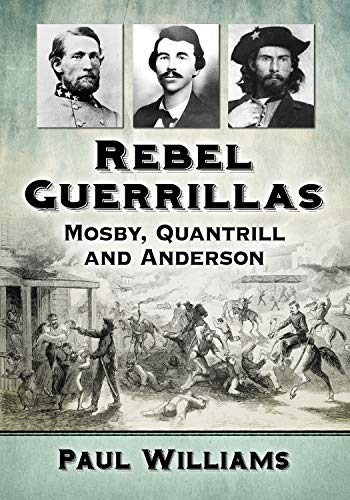Gathering to Save a Nation: Lincoln and the Union’s War Governors by Stephen D. Engle. The University of North Carolina Press, 2016. Cloth, IBSN: 978-1469629339. $49.95.
 In Gathering to Save a Nation, Stephen Engle suggests that that the United States Civil War “was as much a story of cooperation as it was of conflict” (1). To make this sweeping argument, Engle marshals correspondence from every Union governor. Engle’s impressive primary research grounds Gathering to Save a Nation in the words and actions of the Union’s highest ranking civilian officials. While Engle focuses on a core group of governors, such as John Andrew and Andrew Curtin, his arguments have broad implications. He suggests that Union governors administered mobilization efforts, promoted Unionism, and acted as a bulwark for federalism.
In Gathering to Save a Nation, Stephen Engle suggests that that the United States Civil War “was as much a story of cooperation as it was of conflict” (1). To make this sweeping argument, Engle marshals correspondence from every Union governor. Engle’s impressive primary research grounds Gathering to Save a Nation in the words and actions of the Union’s highest ranking civilian officials. While Engle focuses on a core group of governors, such as John Andrew and Andrew Curtin, his arguments have broad implications. He suggests that Union governors administered mobilization efforts, promoted Unionism, and acted as a bulwark for federalism.
Without a sizable standing army, Washington relied upon state officials to fill the ranks with local volunteers. While many historians have discussed the role of state militias in early 1861, Engle suggests that scholars have failed to recognize the considerable power wielded by state officials throughout the course of the war. He notes, “state executives became commanders in chief in national crisis, and they harnessed the state’s resources that supported the national administration” (33). Besides providing Washington with troops, governors used state buildings as arsenals, command centers, and headquarters for relief organizations. Connecticut governor William A. Buckingham even used his office in the state capitol as a warehouse for vegetables.
According to Engle, Lincoln understood the power wielded by governors and sought to cultivate cordial relations with state capitols. Viewing the states as sinews of Union power, Lincoln made governors equal partners in the business of war. Engle notes, “Lincoln understood the need to lean on the governors and expected cooperation from them in preserving the Union” (33). Engle suggests that mobilization and dependence between Washington and the states fostered a Unionist nationalism. Like Yael Sternhell’s arguments about Confederate nationalism, Engle boldly asserts that the movement of people and resources within the North created an ardent Unionism.
Pushed by the exigencies of war preparedness, Union governors called on Lincoln to implement an exhaustive strategy. While Lincoln attempted to placate border states by conducting a limited war, governors argued that the full authority of the federal and state governments were necessary to stifle rebellion. Engle suggests that Union governors crafted new understandings of federalism to push the administration toward prosecuting a more vigorous war. Collaboration was manifested by the passage of the first national income tax, a new tariff, extended military enlistment periods, and a $250 million loan.
With governors serving as key advisors to Washington, Engle suggests that both federal and state power expanded during the war. He argues, “given the federal structure of antebellum mobilization that leaned on the state militias, governors held extraordinary power in wartime” (2). Marked by mobilization, nationalism, and federalism, the shape of Union authority markedly shifted between 1861 and 1865. The war served as a pivot between a limited antebellum state to an expansive and activist federal state. While the Civil War has often been denoted as a fulcrum between a weak and strong state, Engle adds nuance to historical understandings of just how the state expanded. He forces historians to consider Union governors as critical actors in the creation of a more active federal government.
Nonetheless, the Northern voting public is noticeably absent in this account. While Engle foregrounds governor’s relations with Lincoln, one is left wondering how governors responded to local pressures, especially from women on the home front. With election cycles shorter, ranging from one to four years, Union governors were attuned to citizens’ concerns. However, Engle fails to engage with how constituents shaped governors’ understandings of mobilization, nationalism, or federalism. An extended analysis of how governors responded to local activism promises to reap rewards for future scholars. In doing so, historians may be able to track what Gary Gerstle has called the compromises that created American state power.
Gathering to Save a Nation is useful for untangling how mobilization occurred across the North. Serving as commanders of state militias, governors bore the burden of preparing the nation for war and acted as intermediaries between federal and local authorities. Governors’ role as conduits offered them the ability to shape Union conduct of the war. In doing so, Engle shows that governors were tendrils of the state and enabled Union victory. Thus, Gathering to Save a Nation should be read by anyone interested in the growth of federal authority, as well as political historians of the Civil War Era.
James G. Kopaczewski is a doctoral student in History at Temple University.
